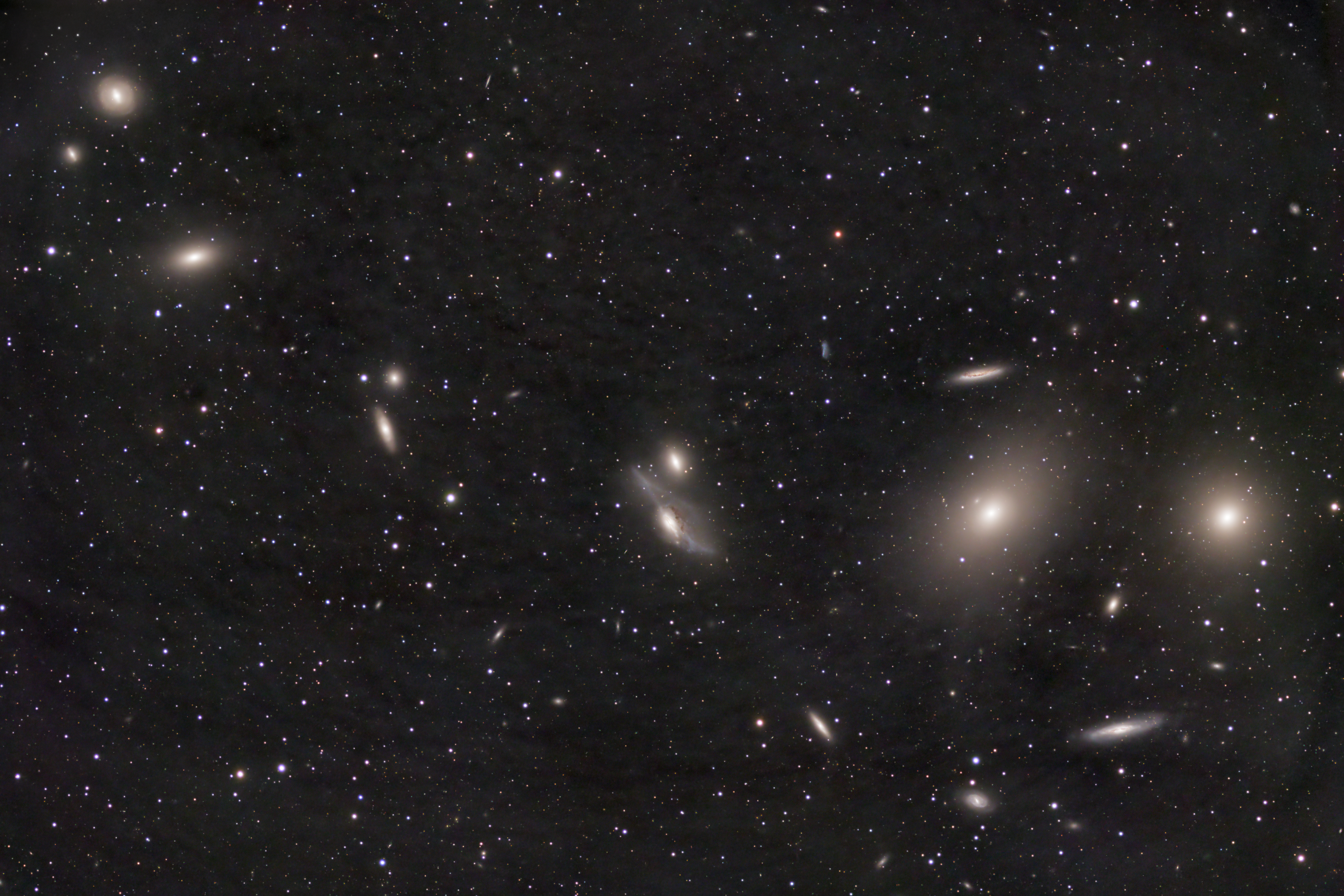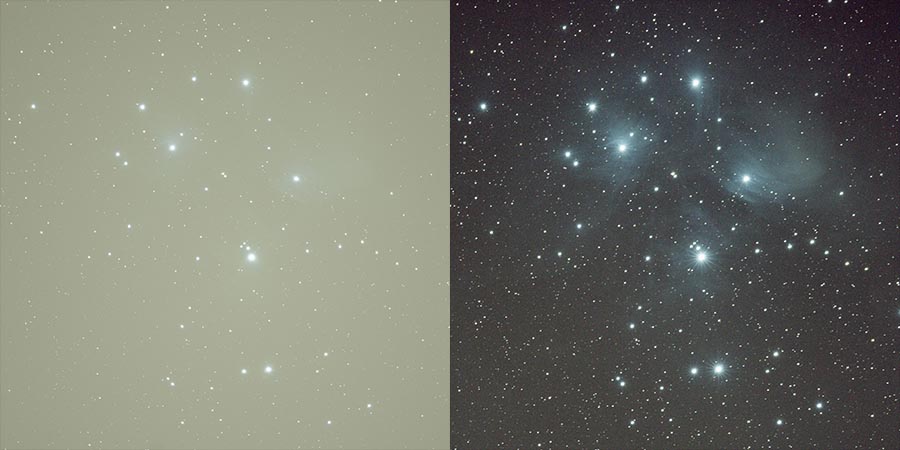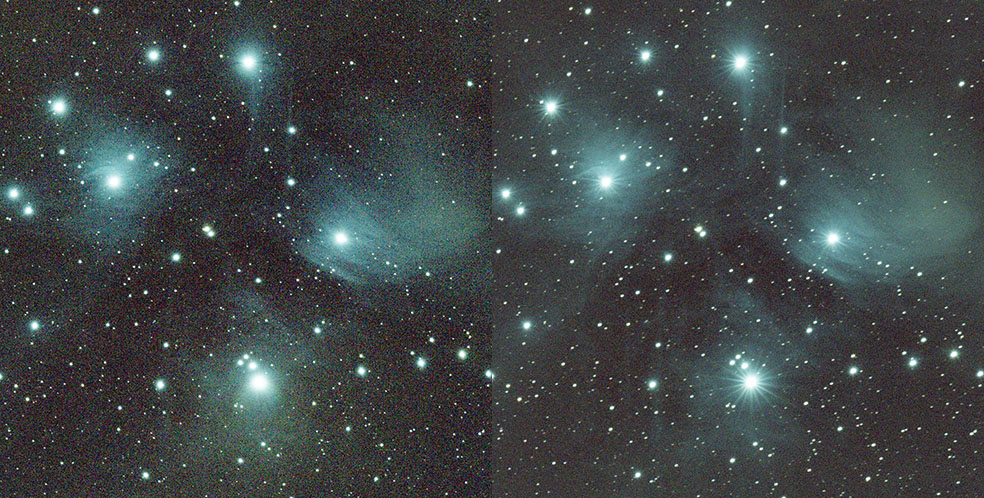Hi,
as I always stated, image processing isn't my thing. But while forcing myself to progress in this field, I ran into some issues no tutorial seems to care about. Let's explain the problem.
For my latest images I took the time to collect at least 15 hours of data. This is a general rule I created for myself. So I collected a lot of data on less images and I am always excited to see what the master frames look like. Who won't? When I open the masters in Pixinsight, they show a lot of things going on especially in the background. As many tutorials about DBE or similar tools show, there are always gradients of different kinds visible. That's what these tools are designed for and they handle removing them really well. But I wonder, if all the stuff that I try to remove is really trash. There are two main examples:
1)
I did image Markarjans chain the other day and the masters showed a quite foggy background. You might see it in the image I uploaded. The structure seems to be weird for a simple gradient. So I wonder, if this may be real. The color is quite neutral and so it must be on every color channel and the Luminance as well. (I can't look at the masters at the moment) It looks like it belongs there. But how do I know? Are these things real and should be left in the image? If they are real, they should appear with longer exposure times, shouldn't they? We do take a lot of subs to get those details out of the noise, right?

2)
The same exact thing happened when I imaged M81 as well. You can't see it as detailed as on the Markarjans chain image, but it is there. And it is even better visible in the master frames. The background of the uploaded image was darkened a bit too much, but it hides those things. I wonder, if it has to hide those things.

So there are some questions I need some answers or suggestions to:
Are those things real and if not, what causes such strange things? Is there a way to avoid them? There are other subjects I imaged where the background is quite even and has no issues at all.
If the details are real, why then so many people seems to work so hard to remove them? I understand the "beauty" of clean images as art. But from a scientific point of view it might be a bad idea to remove this stuff.
How do YOU decide whether such things are part of the sky angle you image? At least I saw some images of M81 on the web, that showed such foggy regions around the galaxy (distances not taken into account). So I am not the only one who experienced these things.
So what is real (and in my opinion should be included in the final image) and what is not real (and should be thrown out)?
Thank you for sharing your thoughts.
CS
Christian
as I always stated, image processing isn't my thing. But while forcing myself to progress in this field, I ran into some issues no tutorial seems to care about. Let's explain the problem.
For my latest images I took the time to collect at least 15 hours of data. This is a general rule I created for myself. So I collected a lot of data on less images and I am always excited to see what the master frames look like. Who won't? When I open the masters in Pixinsight, they show a lot of things going on especially in the background. As many tutorials about DBE or similar tools show, there are always gradients of different kinds visible. That's what these tools are designed for and they handle removing them really well. But I wonder, if all the stuff that I try to remove is really trash. There are two main examples:
1)
I did image Markarjans chain the other day and the masters showed a quite foggy background. You might see it in the image I uploaded. The structure seems to be weird for a simple gradient. So I wonder, if this may be real. The color is quite neutral and so it must be on every color channel and the Luminance as well. (I can't look at the masters at the moment) It looks like it belongs there. But how do I know? Are these things real and should be left in the image? If they are real, they should appear with longer exposure times, shouldn't they? We do take a lot of subs to get those details out of the noise, right?

2)
The same exact thing happened when I imaged M81 as well. You can't see it as detailed as on the Markarjans chain image, but it is there. And it is even better visible in the master frames. The background of the uploaded image was darkened a bit too much, but it hides those things. I wonder, if it has to hide those things.

So there are some questions I need some answers or suggestions to:
Are those things real and if not, what causes such strange things? Is there a way to avoid them? There are other subjects I imaged where the background is quite even and has no issues at all.
If the details are real, why then so many people seems to work so hard to remove them? I understand the "beauty" of clean images as art. But from a scientific point of view it might be a bad idea to remove this stuff.
How do YOU decide whether such things are part of the sky angle you image? At least I saw some images of M81 on the web, that showed such foggy regions around the galaxy (distances not taken into account). So I am not the only one who experienced these things.
So what is real (and in my opinion should be included in the final image) and what is not real (and should be thrown out)?
Thank you for sharing your thoughts.
CS
Christian

